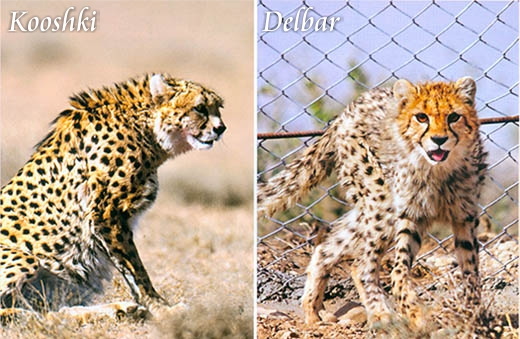Now that they are engaged, they are no longer kept in solitary confinement. Rather, they can enjoy togetherness, plan their future and decide, for instance, where they are willing to spend their honeymoon and how they would like their future married life to be like. If they decided to brush aside the family planning motto of “Fewer children, better life”, Delbar and Kooshki, two Asiatic cheetah cubs, would cheer up environmentalists and wildlife lovers. What comes below is a partial translation of a short report monthly magazine Sarzamin-e Man [My Land] carried in late December:
“The encounter was short and passed off without any incident,” said Houman Jokar, the manager of Conservation of Asiatic Cheetah.
He went on to say that after considerable discussion, Delbar, a 3-year-old female cub and Kooshki, a seven-year-old male, which are the only Asiatic cheetahs in captivity in the world were finally transferred to Tehran to be looked after in a research site established to study the behavior and reproduction patterns of Asiatic cheetahs. The research center is not aimed at reproducing cheetahs in captivity, though.
Kooshki, which was rescued from poachers in 2007, was taken care in Mian Dasht Wildlife Sanctuary in North Khorasan Province. In 2011 when Delbar showed up [actually she was found by an Afghan shepherd in Khar Turan National Park in Semnan Province], the two cheetahs were handed over to the Environment Protection Organization.
Many wondered why the Environment Protection Organization did not seek to reproduce cheetahs in captivity and later release them into the wild to give the frail, endangered population of 50 to 70 Asiatic cheetahs a shot in the arm.
Although Conservation of Asiatic Cheetah is not responsible for the management of the Tehran research center, experts working on the conservation project have explicitly stated that cheetahs are sensitive species and shots at their reproduction in captivity usually fail.
Besides, reproduction in captivity which is meant to save wild animals like cheetahs from extinction has proven futile. Iranian wildlife experts as well as other conservationists across the world believe that provision of safe natural habitats for Asiatic cheetahs is the key to their survival.
However, the two cheetahs were transferred to Tehran to be studied in the research center.
In response to a question as to why the studies in question were not carried out either in Mian Dasht Wildlife Sanctuary or Khar Turan National Park ,which are the natural habitats of the animal, the Environment Protection Organization pointed a finger of blame at the lack of equipment and absence of enough veterinarians and specialists and said it’s costly to get equipment transferred from Tehran to such places.
[…]
Contrary to expectation, the first brief encounter between Kooshki and Delbar from behind bars in December did not produce any negative reaction by either big cat.
However, it remains to be seen whether the results of the research by the site and future visits between the couple could have a positive impact on endangered cheetahs.
